How Fast Do Bullet Trains Travel? SIXT.VN is here to explore the speeds of bullet trains worldwide and how this technology could revolutionize travel in Vietnam. Discover how SIXT.VN’s travel services can enhance your Vietnam experience with convenient transportation options. Let’s explore high-speed rail, rail transport, and train travel for seamless journeys.
1. What is the Speed of Bullet Trains?
Bullet trains, renowned for their high speed, typically operate at speeds ranging from 200 km/h (124 mph) to over 350 km/h (217 mph). These trains utilize advanced technology to minimize friction and maximize efficiency, allowing for swift and comfortable travel. According to research from the Railway Technology, bullet trains combine speed and efficiency.
1.1 Factors Affecting the Speed of Bullet Trains
Several factors influence the speed of bullet trains:
- Track Conditions: Well-maintained and specifically designed tracks are crucial for high-speed operations.
- Train Technology: Modern trains with advanced aerodynamics and propulsion systems achieve higher speeds.
- Safety Regulations: Stringent safety protocols ensure trains operate within safe speed limits.
- Environmental Conditions: Weather conditions, such as heavy rain or snow, can affect operational speeds.
- Infrastructure: Advanced signaling and control systems are essential for managing high-speed train movements.
- Power Supply: A reliable and high-capacity power supply is required to maintain consistent speeds.
1.2 The Role of Aerodynamics in Bullet Train Speed
Aerodynamics play a crucial role in enabling bullet trains to achieve and maintain high speeds. The streamlined design of these trains reduces air resistance, allowing them to move more efficiently. Key aerodynamic features include:
- Nose Shape: The pointed or streamlined nose reduces air pressure and turbulence.
- Smooth Surfaces: Minimal protrusions and smooth body panels decrease drag.
- Underbody Fairings: These reduce air turbulence beneath the train.
- Aerodynamic Wings: Some trains use small wings to stabilize airflow at high speeds.
1.3. How Bullet Trains are Revolutionizing Travel in the Region
Bullet trains are revolutionizing travel in several regions by providing a faster, more efficient, and environmentally friendly alternative to traditional transportation methods. These high-speed trains reduce travel times between major cities, making it easier for people to commute for work or leisure. Bullet trains also boost regional economies by facilitating trade and tourism.
Consider SIXT.VN for reliable airport transfer in Hanoi, ensuring a seamless transition from your flight to your destination.
2. What are Some of the Fastest Bullet Trains in the World?
Several countries have invested in high-speed rail technology, resulting in some of the fastest bullet trains globally. Here are some notable examples:
2.1 Shanghai Maglev, China (460 km/h)
The Shanghai Maglev is the world’s fastest commercial train, reaching a top speed of 460 km/h (286 mph). This magnetic levitation train uses electromagnetic force to float above the track, eliminating friction and allowing for incredibly smooth and quiet travel.
2.2 CR Harmony, China (350 km/h)
The CR Harmony series, also known as Hexie, represents China’s advancements in high-speed rail technology. These trains operate at a top speed of 350 km/h (217 mph) and have recorded even higher speeds during testing.
2.3 CR Fuxing, China (350 km/h)
The CR Fuxing series is another impressive achievement by China Railway. These trains also run at 350 km/h (217 mph) and incorporate domestically produced technology, showcasing China’s self-reliance in high-speed rail development.
2.4 DB ICE, Germany (330 km/h)
The ICE (Intercity-Express) trains in Germany are known for their comfort and efficiency. The ICE 3 class is authorized to run at speeds of up to 330 km/h (205 mph) on certain routes, making it one of Europe’s fastest trains.
2.5 SNCF TGV, France (320 km/h)
France’s TGV (Train à Grande Vitesse) is a pioneer in high-speed rail travel. Operating at speeds of 320 km/h (199 mph), the TGV network connects major cities in France and extends to neighboring countries.
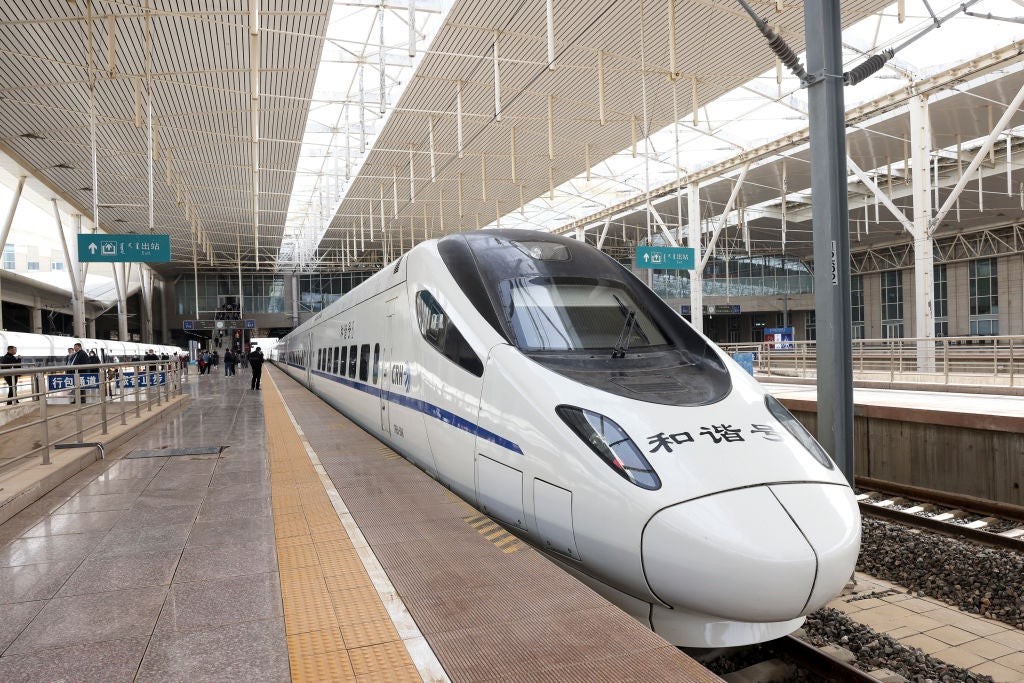 A CR Harmony sitting at a station platform on the China high-speed railway. It is reportedly based on Sthe Shinkansen.
A CR Harmony sitting at a station platform on the China high-speed railway. It is reportedly based on Sthe Shinkansen.
2.6 The Impact of Maglev Technology on Train Speed
Maglev (magnetic levitation) technology significantly enhances train speed by eliminating the friction between the train and the track. Here’s how it works:
- Levitation: Maglev trains use powerful magnets to levitate above the track, reducing friction.
- Propulsion: Electromagnetic propulsion systems drive the train forward, achieving high speeds.
- Stability: Advanced control systems ensure stability and a smooth ride.
2.7 Comparing High-Speed Rail Networks: China vs. Europe
China and Europe have distinct approaches to high-speed rail development:
China:
- Extensive Network: China boasts the world’s most extensive high-speed rail network.
- Rapid Construction: Known for its rapid construction and expansion of rail lines.
- Advanced Technology: Incorporates both imported and domestically developed technologies.
Europe:
- Established Systems: Europe has a long history of high-speed rail with established networks.
- International Connectivity: Focuses on connecting multiple countries through rail.
- Technological Innovation: Continues to innovate with new train models and infrastructure.
For tourists in Hanoi, SIXT.VN provides Hanoi car rental options, allowing you to explore the city at your own pace.
3. How Do Bullet Train Speeds Compare to Other Modes of Transportation?
Bullet trains offer a unique advantage in terms of speed, efficiency, and convenience when compared to other transportation methods.
3.1 Bullet Trains vs. Airplanes: Speed and Efficiency
- Speed: Bullet trains can reach speeds comparable to airplanes for short to medium distances.
- Efficiency: Trains are more fuel-efficient per passenger than airplanes, reducing carbon emissions.
- Convenience: Trains often depart and arrive in city centers, eliminating the need for airport transfers.
- Cost: Train travel can be more economical than flying, especially when considering airport fees and transfers.
3.2 Bullet Trains vs. Cars: Travel Time and Comfort
- Travel Time: Bullet trains significantly reduce travel time compared to cars, especially on long journeys.
- Comfort: Trains offer comfortable seating, onboard amenities, and the freedom to move around.
- Stress Reduction: Passengers can relax or work during the journey without the stress of driving.
- Environmental Impact: Trains produce fewer emissions per passenger compared to cars, promoting sustainable travel.
3.3 The Environmental Benefits of High-Speed Rail
High-speed rail offers several environmental advantages over other modes of transportation:
- Lower Emissions: Trains produce fewer greenhouse gas emissions per passenger compared to airplanes and cars.
- Reduced Congestion: By diverting passengers from air and road travel, trains help reduce traffic congestion.
- Energy Efficiency: Trains are more energy-efficient, consuming less fuel per passenger kilometer.
- Land Use: Rail infrastructure requires less land compared to highways and airports.
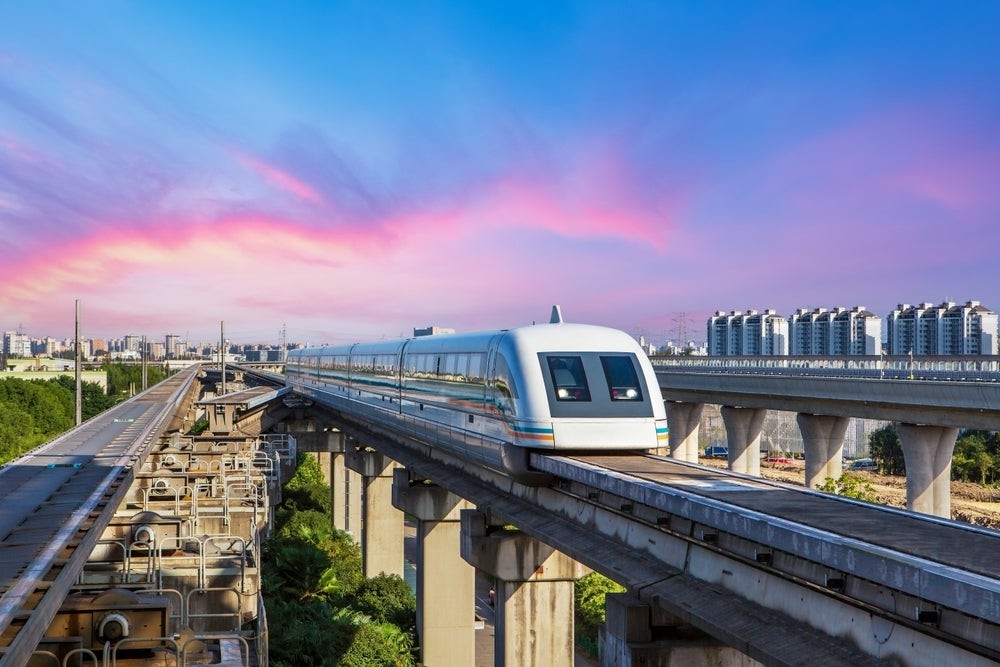 The Shanghai Maglev in operation.
The Shanghai Maglev in operation.
3.4 The Future of Sustainable Travel with Bullet Trains
Bullet trains represent a key component of sustainable travel. As technology advances, these trains are becoming even more environmentally friendly through:
- Renewable Energy: Integration with renewable energy sources to power train operations.
- Improved Aerodynamics: Further reducing energy consumption through advanced train designs.
- Smart Technology: Implementing smart systems to optimize train schedules and energy use.
SIXT.VN’s airport car service in Hanoi ensures a smooth and eco-friendly start to your travels.
4. What is the Potential for Bullet Trains in Vietnam?
The introduction of bullet trains in Vietnam could transform the country’s transportation landscape, offering numerous economic and social benefits.
4.1 Current Transportation Infrastructure in Vietnam
Vietnam’s current transportation infrastructure includes:
- Roads: An extensive network of roads, but often congested, especially in urban areas.
- Airports: Several international and domestic airports, primarily serving long-distance travel.
- Railways: An aging railway system that is slower compared to modern high-speed networks.
- Waterways: Rivers and canals used for cargo transport, but less suitable for passenger travel.
4.2 The Benefits of Implementing Bullet Trains in Vietnam
Implementing bullet trains in Vietnam could bring several key advantages:
- Reduced Travel Times: Faster travel between major cities, boosting productivity and tourism.
- Economic Growth: Stimulating regional economies by improving connectivity and access.
- Reduced Congestion: Alleviating traffic congestion on roads and at airports.
- Environmental Benefits: Lowering carbon emissions compared to air and road travel.
- Modernization: Enhancing Vietnam’s image as a modern, forward-thinking nation.
4.3 Challenges to Building a High-Speed Rail Network in Vietnam
Despite the potential benefits, building a high-speed rail network in Vietnam presents several challenges:
- High Costs: Significant investment required for infrastructure, technology, and land acquisition.
- Technical Expertise: Need for specialized knowledge in high-speed rail construction and operation.
- Environmental Impact: Careful planning to minimize environmental disruption during construction.
- Financial Sustainability: Ensuring the long-term economic viability of the project.
4.4 Potential Routes and Impact on Tourism
Potential high-speed rail routes in Vietnam could include:
- Hanoi to Ho Chi Minh City: Connecting the two largest cities, boosting economic and cultural exchange.
- Hanoi to Coastal Cities: Linking tourist destinations like Ha Long Bay, enhancing tourism revenue.
- Ho Chi Minh City to Mekong Delta: Improving access to agricultural regions, supporting economic development.
These routes would significantly impact tourism by:
- Increasing Accessibility: Making it easier for tourists to visit multiple destinations.
- Promoting Domestic Travel: Encouraging more Vietnamese citizens to explore their country.
- Boosting Local Economies: Driving growth in tourism-related industries along the rail lines.
SIXT.VN can assist with hotel bookings in Hanoi, ensuring you have a comfortable place to stay during your visit.
5. How Can SIXT.VN Enhance Your Travel Experience in Vietnam?
SIXT.VN offers a range of services designed to make your travel experience in Vietnam as smooth and enjoyable as possible.
5.1 Airport Transfer Services for Seamless Travel
SIXT.VN provides reliable and efficient airport transfer services, ensuring a stress-free start to your trip. Key benefits include:
- Professional Drivers: Experienced and courteous drivers who know the local area.
- Comfortable Vehicles: A range of vehicles to suit your needs, from sedans to SUVs.
- Punctuality: Timely pickups and drop-offs, ensuring you reach your destination on time.
- Convenience: Easy online booking and transparent pricing.
5.2 Car Rental Options for Exploring Vietnam at Your Own Pace
With SIXT.VN’s car rental options, you can explore Vietnam at your own pace. Benefits include:
- Wide Selection: A variety of vehicles to choose from, including cars, SUVs, and vans.
- Flexibility: The freedom to travel wherever you want, whenever you want.
- Convenience: Pick-up and drop-off locations throughout Vietnam.
- Support: 24/7 customer support to assist you with any issues.
5.3 Hotel Booking Services for a Comfortable Stay
SIXT.VN offers a comprehensive hotel booking service, ensuring you find the perfect accommodation for your needs. Advantages include:
- Extensive Selection: A wide range of hotels, from budget-friendly options to luxury resorts.
- Competitive Prices: Best rates guaranteed, saving you money on your stay.
- Convenience: Easy online booking and secure payment options.
- Reviews: Access to reviews from other travelers to help you make informed decisions.
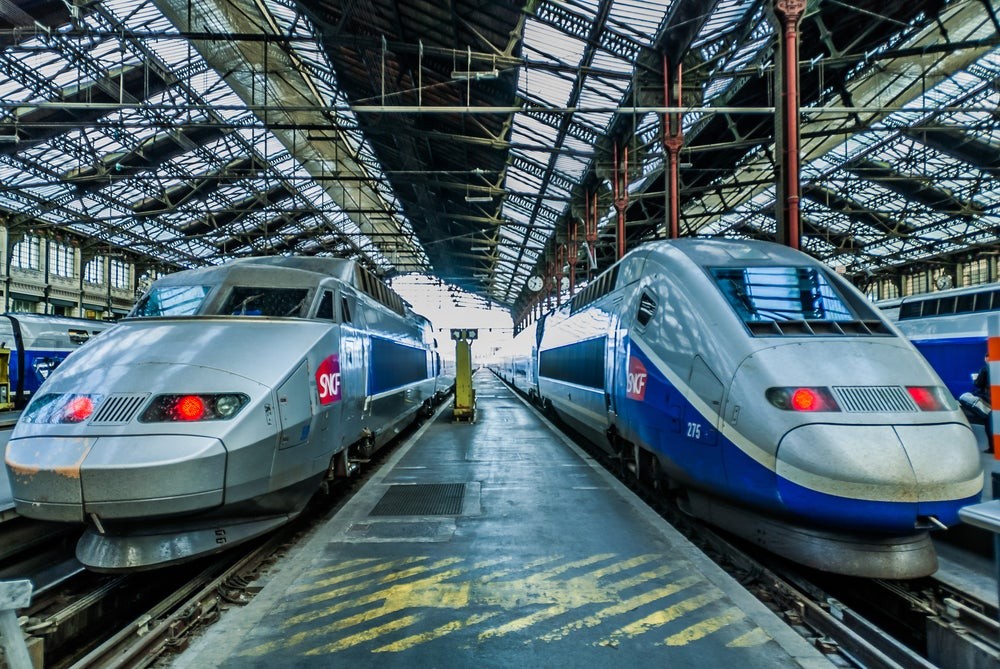 Two TGVs at Gare de Lyon station in Paris, France
Two TGVs at Gare de Lyon station in Paris, France
5.4 Tour Packages to Discover the Best of Vietnam
SIXT.VN provides a variety of tour packages designed to showcase the best of Vietnam. Benefits include:
- Curated Experiences: Carefully planned itineraries that highlight top attractions and hidden gems.
- Local Guides: Knowledgeable guides who provide insights into Vietnam’s history and culture.
- Hassle-Free Travel: All arrangements taken care of, from transportation to accommodation.
- Customization: Options to tailor tour packages to your interests and preferences.
Contact SIXT.VN at Address: 260 Cau Giay, Hanoi, Vietnam or call our Hotline/Whatsapp: +84 986 244 358 for more details.
6. What are Some Tips for Traveling by Train in Vietnam?
Traveling by train in Vietnam can be an exciting and rewarding experience. Here are some tips to help you make the most of your journey:
6.1 Booking Tickets and Choosing the Right Class
- Book in Advance: Especially during peak seasons, booking your tickets in advance is essential.
- Online Booking: Use reliable online platforms to book tickets and secure your seats.
- Class Options: Choose the right class based on your budget and comfort preferences. Options typically include:
- Soft Sleeper: Comfortable berths in a shared compartment.
- Hard Sleeper: More basic sleeping arrangements, often more economical.
- Soft Seat: Padded seats suitable for shorter journeys.
- Hard Seat: Basic seating, the most budget-friendly option.
6.2 What to Pack for a Comfortable Train Journey
- Essentials:
- Tickets and travel documents.
- Identification (passport or ID card).
- Cash (for onboard purchases and small vendors).
- Comfort Items:
- Pillow and blanket (especially for overnight journeys).
- Eye mask and earplugs.
- Comfortable clothing.
- Entertainment:
- Books, magazines, or e-reader.
- Music player or smartphone with downloaded content.
- Portable charger.
- Snacks and Drinks:
- Pack non-perishable snacks.
- Bring a reusable water bottle to refill.
- Personal Care:
- Hand sanitizer.
- Wet wipes.
- Toiletries.
6.3 Understanding Train Schedules and Routes
- Check Schedules: Verify train schedules in advance, as they can change.
- Route Maps: Familiarize yourself with the train route to anticipate stops and transfers.
- Station Information: Know the location of your departure and arrival stations.
- Delays: Be prepared for potential delays, especially during adverse weather conditions.
6.4 Safety Tips for Train Travel in Vietnam
- Secure Belongings: Keep your valuables secure and within sight.
- Be Aware: Stay vigilant and aware of your surroundings.
- Emergency Contacts: Have emergency contact information readily available.
- Health Precautions: Carry any necessary medications and a basic first-aid kit.
SIXT.VN’s Hanoi travel guide offers additional insights and tips for exploring the city.
7. What Are Some Popular Tourist Destinations Accessible by Train in Vietnam?
Vietnam’s railway network connects numerous popular tourist destinations, making train travel a convenient way to explore the country.
7.1 Hanoi: The Capital City
Hanoi, the capital of Vietnam, is a vibrant city rich in history and culture. Key attractions include:
- Old Quarter: A maze of narrow streets filled with shops, street food vendors, and historical sites.
- Hoan Kiem Lake: A picturesque lake with Ngoc Son Temple located on a small island.
- Ho Chi Minh Mausoleum: The final resting place of Ho Chi Minh, Vietnam’s revolutionary leader.
- Temple of Literature: Vietnam’s first university, showcasing traditional architecture.
7.2 Sapa: Mountainous Beauty
Sapa, located in the northern mountains, is known for its stunning landscapes and trekking opportunities. Key attractions include:
- Fansipan Peak: The highest peak in Indochina, accessible by cable car or hiking.
- Rice Terraces: Breathtaking terraced rice fields carved into the hillsides.
- Ethnic Villages: Home to various ethnic minority groups, offering unique cultural experiences.
- Bac Ha Market: A colorful Sunday market where locals trade goods and handicrafts.
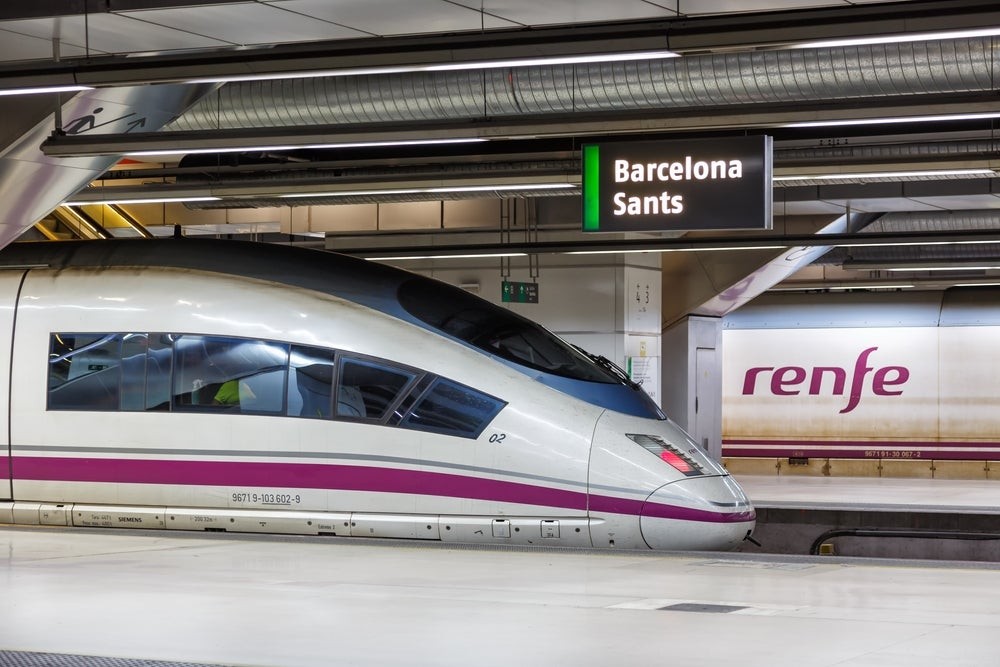 A Siemens Velaro train at Barcelona station in Spain
A Siemens Velaro train at Barcelona station in Spain
7.3 Hue: Imperial City
Hue, the former imperial capital, is a city of historical significance. Key attractions include:
- Imperial Citadel: A sprawling complex of palaces, temples, and gardens.
- Perfume River: A scenic river that flows through the city, offering boat tours.
- Tombs of the Emperors: Elaborate mausoleums dedicated to former emperors.
- Thien Mu Pagoda: A historic pagoda overlooking the Perfume River.
7.4 Da Nang: Coastal Charm
Da Nang, a coastal city, offers beautiful beaches and modern attractions. Key attractions include:
- My Khe Beach: One of Vietnam’s most beautiful beaches, perfect for swimming and sunbathing.
- Marble Mountains: A cluster of limestone hills with caves, temples, and panoramic views.
- Dragon Bridge: A modern bridge that breathes fire and water on weekend nights.
- Ba Na Hills: A mountain resort with a French village, amusement park, and stunning vistas.
7.5 Nha Trang: Beach Paradise
Nha Trang, another coastal city, is known for its pristine beaches and vibrant nightlife. Key attractions include:
- Nha Trang Beach: A long sandy beach perfect for relaxation and water sports.
- Vinpearl Land: An amusement park with rides, a water park, and an aquarium.
- Po Nagar Cham Towers: Ancient Cham towers dating back to the 8th century.
- Hon Mun Island: A marine protected area ideal for snorkeling and diving.
7.6 Ho Chi Minh City: Bustling Metropolis
Ho Chi Minh City, formerly Saigon, is a dynamic city with a mix of modern and historical attractions. Key attractions include:
- Cu Chi Tunnels: An extensive network of underground tunnels used during the Vietnam War.
- War Remnants Museum: A museum showcasing artifacts and exhibits related to the war.
- Notre-Dame Cathedral: A beautiful cathedral built in the late 19th century.
- Central Post Office: A historic post office designed by Gustave Eiffel.
SIXT.VN can arrange tours to these destinations, ensuring a memorable travel experience.
8. What are the Latest Innovations in Bullet Train Technology?
Advancements in bullet train technology are continuously pushing the boundaries of speed, safety, and sustainability.
8.1 Hyperloop Technology
Hyperloop technology represents a futuristic vision of high-speed transportation. Key features include:
- Vacuum Tubes: Trains travel through near-vacuum tubes, reducing air resistance.
- Magnetic Levitation: Similar to maglev trains, hyperloop pods levitate to eliminate friction.
- High Speeds: Potential to reach speeds of over 700 mph (1126 km/h).
- Energy Efficiency: Designed to be highly energy-efficient compared to traditional trains.
8.2 Magnetic Levitation (Maglev) Advancements
Maglev technology continues to evolve, with improvements in:
- Superconducting Magnets: More powerful magnets that enhance levitation and speed.
- Guidance Systems: Advanced systems for precise control and stability.
- Infrastructure: Development of more cost-effective and durable track systems.
8.3 Artificial Intelligence (AI) in Train Management
AI is playing an increasing role in bullet train management, offering:
- Predictive Maintenance: Using AI to predict maintenance needs and prevent breakdowns.
- Optimized Scheduling: AI algorithms that optimize train schedules for maximum efficiency.
- Enhanced Safety: AI-powered systems that detect and respond to potential safety hazards.
- Energy Management: AI systems that optimize energy consumption based on real-time conditions.
8.4 Green Technologies for Sustainable Rail Travel
Sustainable technologies are being integrated into bullet trains, including:
- Renewable Energy Sources: Using solar, wind, and hydro power to fuel train operations.
- Energy-Efficient Designs: Aerodynamic designs and lightweight materials to reduce energy consumption.
- Regenerative Braking: Systems that capture and reuse energy during braking.
- Eco-Friendly Materials: Using sustainable and recyclable materials in train construction.
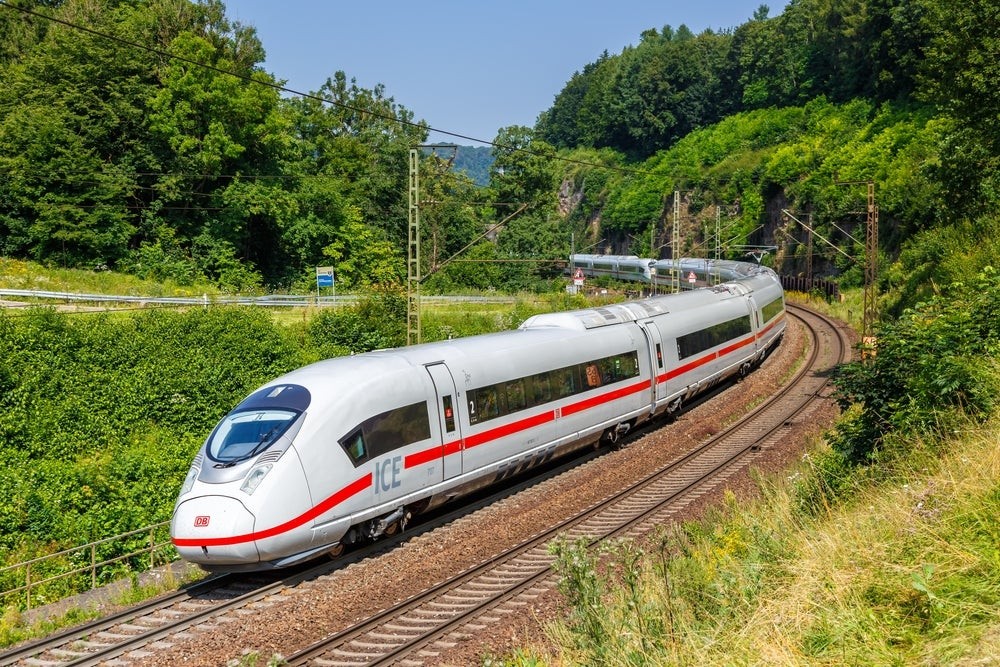 A photo of a DB ICE 3 turning around a bend on a high-speed railway
A photo of a DB ICE 3 turning around a bend on a high-speed railway
9. What are the Safety Measures Implemented in Bullet Trains?
Safety is paramount in bullet train operations, with numerous measures in place to ensure passenger well-being.
9.1 Automatic Train Control (ATC) Systems
ATC systems play a critical role in preventing accidents by:
- Speed Monitoring: Continuously monitoring train speeds and enforcing limits.
- Collision Avoidance: Automatically applying brakes to prevent collisions.
- Signal Compliance: Ensuring trains adhere to signals and track conditions.
- Real-Time Communication: Providing real-time data to train operators and control centers.
9.2 Earthquake Detection and Response Systems
In earthquake-prone regions, bullet trains are equipped with:
- Seismic Sensors: Sensors that detect ground motion and seismic activity.
- Automatic Braking: Systems that automatically apply brakes during an earthquake.
- Emergency Protocols: Procedures for safely stopping trains and evacuating passengers.
- Reinforced Infrastructure: Rail infrastructure designed to withstand seismic forces.
9.3 Fire Detection and Suppression Systems
To protect against fire hazards, bullet trains incorporate:
- Smoke Detectors: Detectors that quickly identify smoke and fire.
- Fire-Resistant Materials: Materials used in train construction that resist fire.
- Automatic Suppression Systems: Systems that automatically extinguish fires.
- Emergency Exits: Clearly marked and easily accessible emergency exits.
9.4 Regular Maintenance and Inspection Procedures
Regular maintenance and inspections are essential for ensuring bullet train safety:
- Daily Checks: Daily inspections of critical systems and components.
- Scheduled Maintenance: Regular maintenance schedules to address wear and tear.
- Advanced Diagnostics: Using advanced diagnostic tools to identify potential issues.
- Component Replacement: Replacing worn or damaged components promptly.
10. What are the Future Trends in High-Speed Rail?
The future of high-speed rail is promising, with several trends shaping the industry.
10.1 Expansion of High-Speed Rail Networks Globally
High-speed rail networks are expanding globally, with new projects planned in:
- North America: Development of high-speed rail lines in the United States and Canada.
- Asia: Continued expansion of networks in China, India, and Southeast Asia.
- Europe: Upgrading and extending existing networks in Western and Eastern Europe.
- Africa: Planning and construction of high-speed lines in several countries.
10.2 Integration with Urban Planning
High-speed rail is increasingly being integrated with urban planning, including:
- Transit-Oriented Development (TOD): Developing mixed-use areas around train stations.
- Improved Connectivity: Enhancing connections between train stations and local transit systems.
- Reduced Urban Sprawl: Encouraging denser, more sustainable urban development.
- Economic Growth: Stimulating economic activity in areas around train stations.
10.3 Focus on Passenger Experience
Future high-speed rail will focus on enhancing the passenger experience through:
- Comfortable Seating: Ergonomic and adjustable seating.
- Onboard Amenities: Wi-Fi, entertainment systems, and food and beverage services.
- Accessibility: Improved accessibility for passengers with disabilities.
- Seamless Ticketing: Integrated ticketing systems for easy booking and transfers.
10.4 Public-Private Partnerships for Funding and Development
Public-private partnerships are becoming more common for funding and developing high-speed rail projects:
- Risk Sharing: Sharing financial risks between public and private entities.
- Private Sector Expertise: Leveraging private sector expertise in construction and operation.
- Innovation: Encouraging innovation through private sector involvement.
- Efficient Management: Improving project management and efficiency.
For a seamless and enjoyable trip, consider SIXT.VN for your Vietnam travel needs. Visit SIXT.VN today to explore our services and start planning your adventure. Address: 260 Cau Giay, Hanoi, Vietnam. Hotline/Whatsapp: +84 986 244 358.
FAQ about Bullet Train Speed
-
How fast do bullet trains travel on average?
Bullet trains typically travel at operational speeds between 200 km/h (124 mph) and 350 km/h (217 mph). -
What is the fastest bullet train in the world?
The Shanghai Maglev is the fastest, reaching a top speed of 460 km/h (286 mph). -
How do bullet train speeds compare to airplanes?
For short to medium distances, bullet trains can be competitive with airplanes in terms of travel time, often more convenient due to city-center departures and arrivals. -
What factors affect how fast a bullet train can travel?
Factors include track conditions, train technology, safety regulations, weather, infrastructure, and power supply. -
Are bullet trains more environmentally friendly than other transportation methods?
Yes, bullet trains generally produce fewer emissions per passenger compared to airplanes and cars, making them a more sustainable option. -
What safety measures are in place for bullet trains?
Safety measures include automatic train control (ATC) systems, earthquake detection, fire detection and suppression systems, and regular maintenance. -
What is maglev technology and how does it affect train speed?
Maglev (magnetic levitation) technology uses magnets to levitate trains above the track, reducing friction and allowing for higher speeds. -
How do bullet trains reduce travel time compared to cars?
Bullet trains travel much faster than cars, especially on long journeys, and allow passengers to relax or work during the trip. -
What are some future innovations in bullet train technology?
Future innovations include hyperloop technology, advancements in maglev, AI in train management, and green technologies. -
What are the benefits of implementing bullet trains in Vietnam?
Implementing bullet trains could reduce travel times, boost economic growth, alleviate traffic congestion, lower emissions, and modernize the country’s infrastructure.



